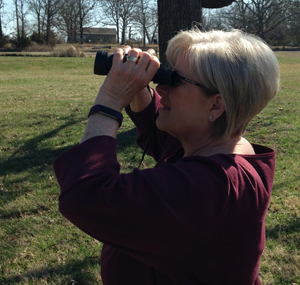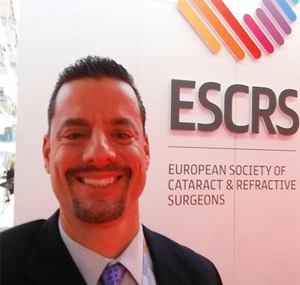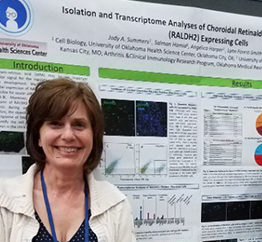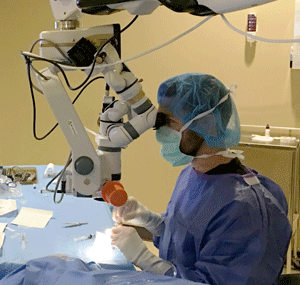M
Leave a Legacy of Giving
You can support our mission of changing lives by saving sight in multiple ways!


“As my vision becomes clearer and clearer I realize that I had forgotten how bright and colorful our world is and I appreciate and love every second of it,” said Pam.
Watching deer graze in the valley and geese land on her pond were just a few of the beautiful sights of nature Pam enjoys at her country home in Lebanon, Mo. Those sights mean more to Pam now than ever before after the hereditary eye disease Fuch’s dystrophy threatened to take her vision away.
“My vision kept getting dimmer and dimmer and glasses just didn’t fix it,” said Pam. “We realized through several tests that it was Fuch’s dystrophy.” As her vision deteriorated, Pam no longer felt safe driving her car because she couldn’t see road signs on the side of the road and was missing important details as she drove. She struggled with daily tasks, began missing out on some her favorite hobbies and even stayed home from family outings because she couldn’t see.

As an avid birdwatcher, Pam is able to see the fine details in feathers and coloring she was missing before her transplant.
As an avid birdwatcher, Pam is able to see the fine details in feathers and coloring she was missing before her transplant.In July of 2016, Pam received a successful cornea transplant at Mattax Neu Prater Surgery Center in Springfield thanks to the generosity of an eye donor. Pam chose to write to her donor family to thank them for their kindness. “Families have felt such a loss but they have helped other people,” said Pam. “I knew they had suffered a loss and just wanted them to know we appreciated the gift. It’s not just that the donor gave but the family accepted and followed through with their wishes.”
Today, Pam has regained her active lifestyle exploring the outdoors and gardening. She and her husband are avid birdwatchers and she is able to see the fine details in feathers and coloring she was missing before her transplant. Pam has regained her independence, driving with confidence again and seeing details when grocery shopping, watching television, reading menus in restaurants and even beading her holiday Christmas balls. More than anything, Pam is able to watch her 6 grandchildren play soccer and their other activities and see the world as they see it.
“As my vision becomes clearer and clearer I realize that I had forgotten how bright and colorful our world is and I appreciate and love every second of it,” said Pam.
 Lets’s connect at ESCRS 2017!
Lets’s connect at ESCRS 2017!
Our Saving Sight team is excited to be back at the annual European Society of Cataract and Refractive Surgeons (ESCRS) Congress October 7-11, 2017. We’d love the opportunity to connect with ophthalmologists, surgeons and other eye care professionals while there. Patrick Gore, Chief Business Development Officer at Saving Sight, will be at ESCRS and looks forward to hearing how Saving Sight can best suit your ocular needs in a simple and convenient way. Please reach out to Patrick Gore soon to coordinate a time to connect at the conference.
We look forward to an enriching conference in Lisbon!
For additional information: Patrick Gore, Chief Business Development Officer, 816.255.1337.


Kansas City, Mo. (July 25, 2017) – Construction is set to begin in August for Saving Sight’s Northland expansion into the former Equity Plaza office building at 10560 NW Ambassador Drive in Kansas City, Platte County. The acquisition of the majority of Equity Plaza building was completed in July and will give the non-profit ocular services provider 18,094 square feet of commercial office space.
Set for completion in late in 2018, the building renovation will feature an open floor plan and other features to enhance collaboration, as well a clean room lab environment for tissue processing. Firms involved in Saving Sight’s new headquarters project include Development Initiatives, Centric Projects, and Clockwork Architecture and Design.
Saving Sight employs 38 of its 87 staff members at its current Kansas City headquarters. As one of the nation’s leading providers of corneal tissue for transplantation, Saving Sight helped to restore sight to 2,950 individuals last year. While the organization has four additional satellite offices throughout Missouri and Illinois, most of its administrative business divisions and all laboratory processing occurs at the Kansas City home office.
Alicia Stephens, Executive Director of the Platte County Economic Development Council, said “We are pleased to share news of Saving Sight’s expansion in Platte County. The growth and redevelopment taking place along Ambassador Drive are a testament to Platte County’s pro-business environment and excellent location. We welcome Saving Sight to the neighborhood.”
About Saving Sight
Saving Sight is a 501(c)(3) nonprofit organization with a mission to change lives by saving sight. Founded in 1960, Saving Sight has grown to become one of the nation’s leading eye banks and is focused on providing innovative solutions to its clinical partners. Headquartered in Kansas City, Mo., Saving Sight facilitates eye donation in Missouri, Kansas, and Illinois, impacting the lives of those both near and far through transplantation.
###
For additional information: Annie Kuhl, Chief Communications Officer, 314.584.1710

Kansas City, Mo. (May 11, 2017) – The millions projected to be diagnosed with myopia, or nearsightedness, in the coming years may soon have an option other than corrective eyewear or refractive surgery to restore their vision. According to new research presented this week at the Annual Meeting of the Association for Research in Vision and Ophthalmology (ARVO), scientists are one step closer to developing a molecular treatment that could slow development of the condition.
 The project, led by Jody Summers, PhD, professor of cell biology at the University of Oklahoma Health Sciences Center, successfully isolated cells in the choroid of both chick and human eyes which have been found to produce the enzyme retinaldehyde dehydrogenase 2 (RALDH2). Previous research by Dr. Summers and her team demonstrated RALDH2 to be important in controlling scleral matrix remodeling. Isolation of the cells which produce the enzyme will allow future projects to identify the cells’ type and pursue development of molecular treatments that target the cells to control overall growth of the eye.
The project, led by Jody Summers, PhD, professor of cell biology at the University of Oklahoma Health Sciences Center, successfully isolated cells in the choroid of both chick and human eyes which have been found to produce the enzyme retinaldehyde dehydrogenase 2 (RALDH2). Previous research by Dr. Summers and her team demonstrated RALDH2 to be important in controlling scleral matrix remodeling. Isolation of the cells which produce the enzyme will allow future projects to identify the cells’ type and pursue development of molecular treatments that target the cells to control overall growth of the eye.
Myopia is the most common refractive error. The condition results when the eye is too long for the focusing power of the cornea and lens of the eye. High myopia can increase the risk of cataracts, glaucoma, retinal detachment and myopic macular degeneration.
“By 2050, high myopia will become the leading cause of blindness in many countries, affecting 1 billion people worldwide,” said Dr. Summers. “By finding a treatment to slow the development of myopia, we could prevent these blinding eye conditions, particularly in children who are most at risk.”
Saving Sight Director of Business Development Lynn Forest-Smith was a co-author on the project. As an eye bank that facilitates eye donation for transplant and research, Forest-Smith said Saving Sight was excited to support this important project with donated eye tissue.
“There may be no better way to honor the gift of our eye donors than through support of research like this which could help save the sight of nearly 5 billion people over the next few decades,” said Forest-Smith.
About Saving Sight
Saving Sight is a 501(c)(3) nonprofit organization with a mission to change lives by saving sight. Founded in 1960, Saving Sight has grown to become one of the nation’s leading eye banks and is focused on providing innovative solutions to its clinical partners. Headquartered in Kansas City, Mo., Saving Sight facilitates eye donation in Missouri, Kansas, and Illinois, impacting the lives of those both near and far through transplantation and eye research.
###


Dr. Ketcherside prepares tissue for transplant during the first Descemet’s membrane endothelial keratoplasty performed with preloaded tissue in the Midwest.
Kansas City, Mo. (May 3, 2017) – An innovative approach to transplanting Descemet’s membrane proves to offer efficiencies, making DMEK procedures simpler and more accessible for cornea surgeons. Preloaded DMEK graft tissue, now available from Kansas City-based eye bank, Saving Sight, is expected to open doors for many more surgeons to perform this type of transplant regionally and across the U.S.
In April, Christopher Ketcherside, MD, of the Kansas City Eye Clinic, performed his first preloaded DMEK graft surgery – a first of its kind in the Midwest.
“It’s always appealing to do things in a more efficient fashion,” said Dr. Ketcherside. “I think that any time we can try to perform steps like this in the eye bank, we’ve learned that it’s probably a good thing. If there are going to be errors with peeling or loading the tissue during that part of the procedure, those issues can be eliminated from the operating room.”
Preloaded DMEK grafts provided by the eye bank can potentially reduce barriers to entry for surgeons considering this advanced transplantation technique. The tissue comes prepared, preloaded, and shipped in a modified Jones tube. This innovative preparation by Saving Sight saves the surgeon time in the operating room. Further clinical evaluation is needed to determine the extent to which patient outcomes are improved with preloaded DMEK grafts.
“We’re thrilled to help make DMEK more accessible to surgeons by providing preloaded tissue,” said Tony Bavuso, CEO of Saving Sight. “Our goal is to partner with eye care professionals to provide innovative solutions that help patients.”
About Saving Sight
Saving Sight is a 501(c)(3) nonprofit organization with a mission to change lives by saving sight. Founded in 1960, Saving Sight has grown to become one of the nation’s leading eye banks and is focused on providing innovative solutions to its clinical partners. Headquartered in Kansas City, Mo., Saving Sight facilitates eye donation in Missouri, Kansas, and Illinois, impacting the lives of those both near and far through transplantation.